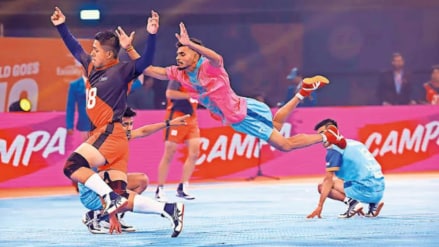Ariel dancers performing to the tunes of the British rock band Coldplay; a group dance performance choreographed by star performer Shiamak Davar; an energetic welcome to players from 23 countries in the presence of Vice-President Jagdeep Dhankhar, Union Sports Minister Mansukh Mandaviya, and IOA President PT Usha. No, not IPL —all that razzmatazz on display earlier this week at New Delhi’s Indira Gandhi Indoor Stadium marked the inauguration of the first edition of the Kho Kho World Cup.
It also marked the culmination of the behind-the-scene efforts by the Kho Kho Federation of India (KKFI) over the past few years to put a sport deeply rooted in Indian tradition onto a global stage.
The KKFI says the World Cup has garnered sponsorships of over `80 crore for the 2025 World Cup, which is double the amount backing Kabaddi this last season. Brands like EaseMyTrip, GMR Aero, Zomato, Blackberrys, and Tata have come on board, signalling kho kho’s potential.
Being aired on Disney+ Hotstar, Star Sports Network and DD Sports in India, the tournament is expected to garner over 200 million viewers, says Mandeep Malhotra, chief marketing officer, KKFI and founder, Shristi Media. The KKFI brass admits setting up a new league in a cricket crazy country is challenging but says it is ready to put in everything it takes to modernise the ancient Indian sport, starting with shifting it from mud courts to mats.
So what will it really take for kho kho to live up to the expectations of today’s sports audiences, who have cut their teeth on the television spectacle that is the Indian Premier League?
Changing speed
Ultimate Kho Kho (UKK), an Indian franchise-based kho kho league hosted by the KKFI since 2022, has done part of the groundwork already. The first season had a viewership of 64 million, 41 million of which came from India, making UKK the third-most viewed non-cricket sports tournament in India after the Pro Kabaddi League and the Indian Super League.
Since then, KKFI has taken a slew of measures to market the sport to bigger audiences. “More than 680 districts have also actively participated in district-level tournaments over the last six months to promote the sport,” Malhotra says. The idea is to democratise the sport, he says, adding, “When you give the ownership of the game to the country, marketing efforts seem easy.”
The federation has roped in celebrities such as Salman Khan and Sachin Tendulkar as ambassadors to grab credibility and eyeballs. “Collaborations with major broadcasters have ensured extensive television and digital coverage, while partnerships with YouTube and OTT platforms expanded accessibility,” points out Yasin Hamidani, director, Media Care Brand Solutions. “Social media campaigns have highlighted player stories, fostering relatability and inspiration among fans,” he adds.
The KKFI has gone out of its way to attract participation from international players to add that much-needed pizzazz. Take a player like Gabriel Barros Coronas, a member of Team Brazil, who used to play flag football, a variant of American football, before he was enlisted to represent his country in the Kho Kho World Cup. “The coach selected some of the better players from our flag football, football and volleyball teams to put together the kho kho team that you see here today,” Coronas says.
But kho kho still has some distance to traverse. Played as a demonstration sport at the 1936 Olympics in Berlin, it did not gather enough support to be included in the Summer Games and since then has been largely eclipsed by India’s unwavering devotion to cricket.
Hamidani says reviving kho kho in a cricket-obsessed nation will require deeper engagement from the youth. To do that, there is need to highlight the sport’s dynamic and fast-paced nature through digital content highlights, player profiles, and behind-the-scenes footage. Gamifying the sport with mobile apps or e-sports tournaments merging tradition with modern tech can work wonders.
Yes, hosting school and college-level tournaments with attractive rewards, as KKFI is doing now, would foster grassroots involvement, but what it needs the most is IPL-esque glamour. Collaborating with influencers and personalities from other sports will make the sport trendy and relatable, say experts. “By blending innovation, accessibility, and youth-centric narratives, kho kho can capture the imagination of the younger generation effectively,” Hamidani concludes.
